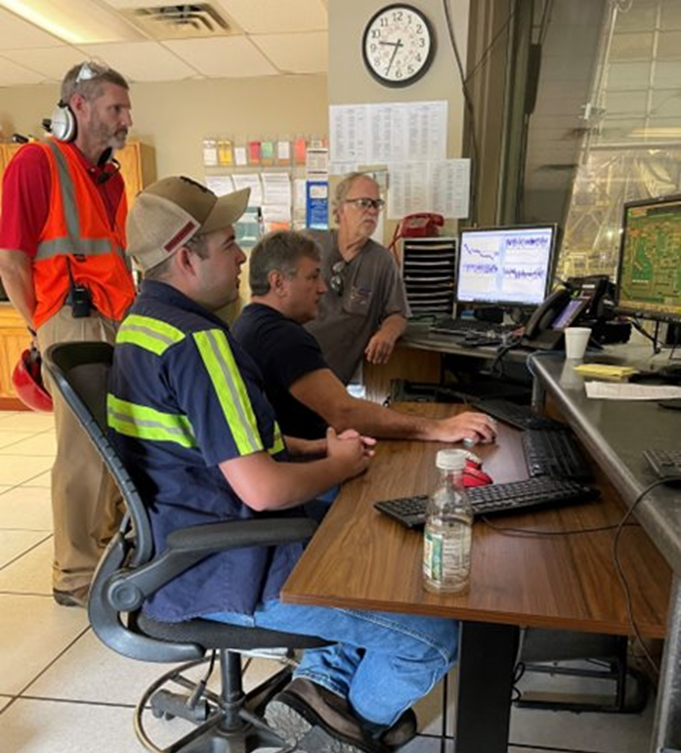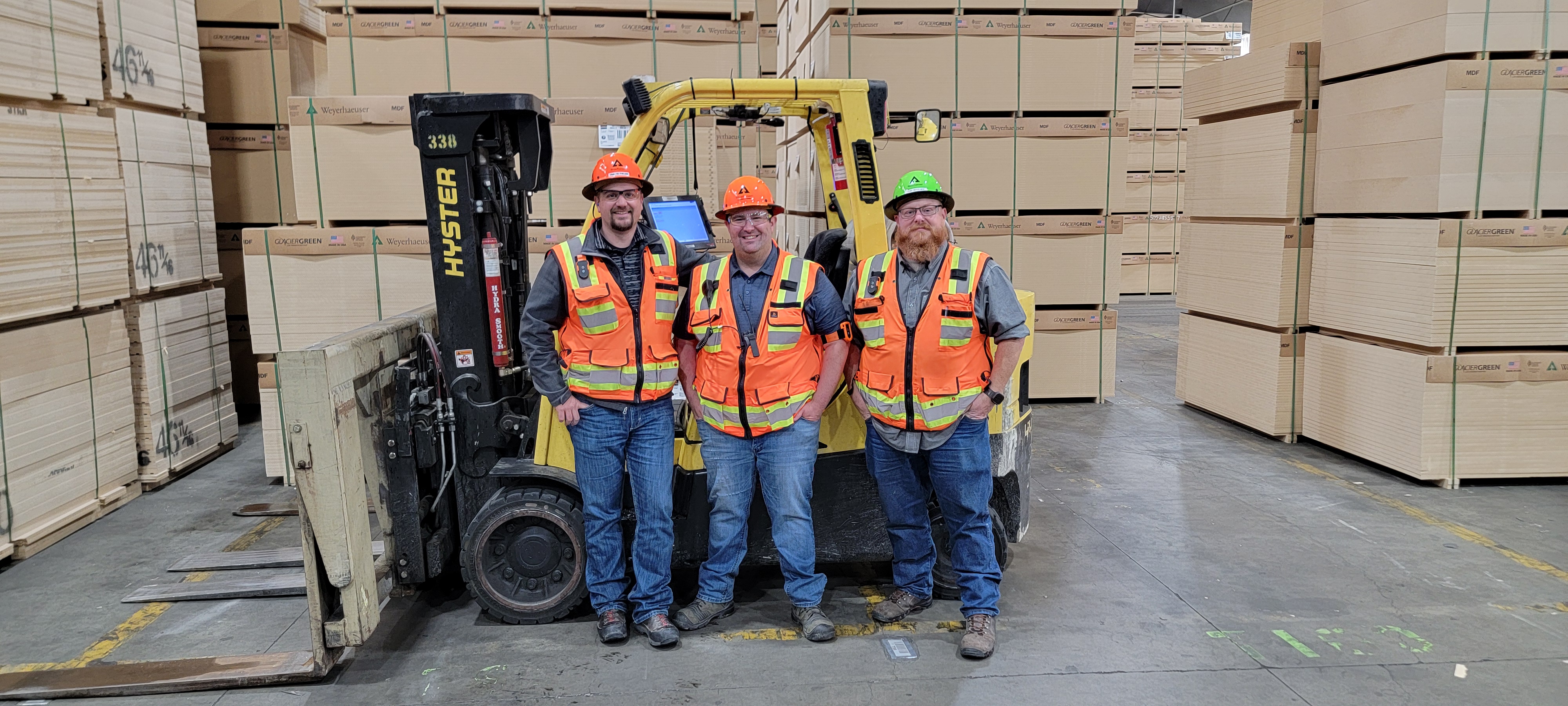
Left to right: Craig Ennis, chief technology officer, Ai2Infinity; Brandon Bleigh, operations team member; Dave Miller, operations team member; and Gary Replogle, process control specialist. “Gary was on the floor just about every day, coaching the operators, asking them questions and getting their feedback in order to refine the process,” says Bruce Honda. “It worked out great to have such a well-rounded team.”
At our Sutton oriented strand board plant in Heaters, West Virginia, 200,000 pounds of wood strands are dried in four sets of triple-pass dryers every hour. Those dry strands are blended with resin and formed into 12-foot-by-24-foot mats, which are then cured in the hot press and cut into 4-foot-by-8-foot boards of high-quality OSB.
Equipment operators working on the dryers watch for variables that can affect the final product, such as mats that are a tad too moist, and make manual adjustments to the dryer temperature settings accordingly. Experienced operators have learned to spot defects in the panels and adjust quickly — though it can take 90 to 120 minutes for those adjustments to be reflected in the manufacturing line. Also, operators can’t instantly analyze large quantities of real-time data available from the dryers, or constantly predict how different variables will interact.
“That’s where artificial intelligence comes in,” says James Liston, technical support engineer. “Our new AI system analyzes thousands of data points and automatically changes the dryer settings in response. It’s kind of like adaptive cruise control on a car.”
The custom AI machine learning system, designed by AI2Infinity, augments the skills and experience of our operators, and it was installed and tested by a large cross-disciplinary team including mill employees, IT specialists and regional leaders.
The collaborative effort earned Sutton a 2023 Wood Products Award for Innovation Breakthrough & Emerging Technology.
Rick Overton, operations team member, and James Liston, technical support engineer. “We see this as operator-driven reliability,” James says. “The AI system frees operators up to focus on other things, including learning new aspects of the manufacturing process.” Bruce adds that Rick was instrumental in helping the implementation team understand all the variables to consider.
A BIG TECHNOLOGICAL LEAP
Equipment operators have many tasks to focus on at once, including monitoring multiple computers, cameras, radios and phones. Classical non-AI process control systems help them control and optimize the dryers and other industrial equipment, but these systems have limitations. And missed signals to change the settings can result in below-standard product quality or equipment downtime.
“In 2021, Alan Sherrington, who was vice president of Panels at the time, asked me to look into a new machine learning product by AI2Infinity,” says Bruce Honda, Wood Products Engineering technical specialist. “He believed it had potential to streamline the production process at the mill, which would in turn make the mill more reliable.”
AI2Infinity’s AI/ML program, called END GAME, uses sensors in the machines to measure variables such as temperature and humidity, then produces a model that constantly monitors the process and can adjust equipment settings in response to changing variables.
“This was our first test of AI on a dryer system, and we were hesitant to spend a lot of effort on a project that might not work,” James says. “But AI2Infinity said, ‘Give us six months’ worth of data, and we’ll tell you if it’s a good fit before you spend any money.’ How many vendors bring that to the table?”
Ted Pendry, operations team member, watches the dryer controls.
OVERCOMING HURDLES TOGETHER
Initially, AI2Infinity supplied its own computer to gather test data. But that wasn’t ideal in terms of our cybersecurity, which has a zero-trust policy for external devices and connections.
“I built a virtual machine on our network from scratch so we’d have ownership of the computer and the security monitoring tools,” James says. “That came with its own complications, but now it’s our machine. We own it, license it and support it, which is really cool.”
An early form of our new companywide Emerging Technology Council also stepped in to help manage the project, providing a streamlined way of identifying and overcoming hurdles involving networking, software and more.
The team fired up the new system for the first time in spring 2022. Then, they worked with Sutton’s experienced operators to assess the model produced by the AI and decide how to use it.
“They were skeptical at first, but after seeing it in action, they’ve come to embrace this technology,” Bruce says.
OPERATORS ARE THE EXPERTS
Sutton’s Gary Replogle, process control lead, and Tim Butcher, electrical engineer, worked with control room operators to learn which variables and parameters would be most useful for the system.
After testing the model’s performance, in April 2023 the team turned on the AI2Infinity program within the existing process control systems, effectively putting the dryers in adaptive cruise control mode. It now optimizes dryer outlet temperature control on all four dryers, consistently maintaining desired surface and core moisture levels on the formline.
“Talking to subject matter experts like the equipment operators and Bruce allowed us to develop this project at a rapid pace,” says Craig Ennis, founder of AI2Infinity. “It’s really a hand-in-glove approach: humans and machines working together to create the best outcomes. The AI program is able to point out patterns nobody was aware of.”
Operators choose whether or not to use the system, which they currently do about 80 percent of the time.
“Ai2Infinity shows promise, especially when training newer operators,” says Ted Pendry, control room operator. “Using it allows me to focus on other things while we’re running. You have to have patience as we work though all the different things that can happen."
The system inactivates itself if anything goes wrong, and any employee can choose to turn it off at any time.
AUTOMATION REPLICATION
The architecture of Sutton’s AI/ML program has now been replicated at our engineered wood products plant in Eugene, Oregon, where it’s maximizing throughput on the veneer presses.
“This technology is self-learning, so it will just get better and better over time,” James says. “Thanks to all the historical data we’ve fed it, the AI is faster at determining when to modify the settings than humans are. I think it has tremendous potential to drive safer and more reliable operations at every facility, in some way or another. This has truly been a remarkable group effort driven by ambition, curiosity and passion. It’s exciting to be at the forefront of new technology that could transform the way our company runs.”
Additional team members who worked on the Sutton AI/ML project include Tim Butcher, John Talbert, Hunter Peyatt, Ricky Overton, Ted Pendry, Debra Jarrett, Duane Read, Wilbur Rose, David Miller, Austin Moore, Sam Dennison, Eric Tucker, Adam Barnette, Billy Harper, Mark Keys, Payton Williams, Brian Fraker, Mike Halvorsen, Laura Dunham, Darcy Hagedorn, Luke Smith, Jacob Skean, John Osborne, Doug Cogar, Tim Sagraves, Kate Bryant, Pam Glaser, Brenda Lewis, Adam Kincaid, Charles Judd and Chris Corder.

